Hello friends. What a strange year: and it was a year in which, as well as moving country and finishing URR 0.8 and doing my usual academic work, I allowed myself some proper time to really play some games as the lockdown weeks stretched on (especially around the middle of the year, the height of lockdowns and the like here in Australia). So here are the games I played this year – a mix of old classics, new releases and those somewhere in the middle – and what I thought of them. Enjoy!
(And what did you all play last year? Tell me in the comments!)
Chrono Trigger
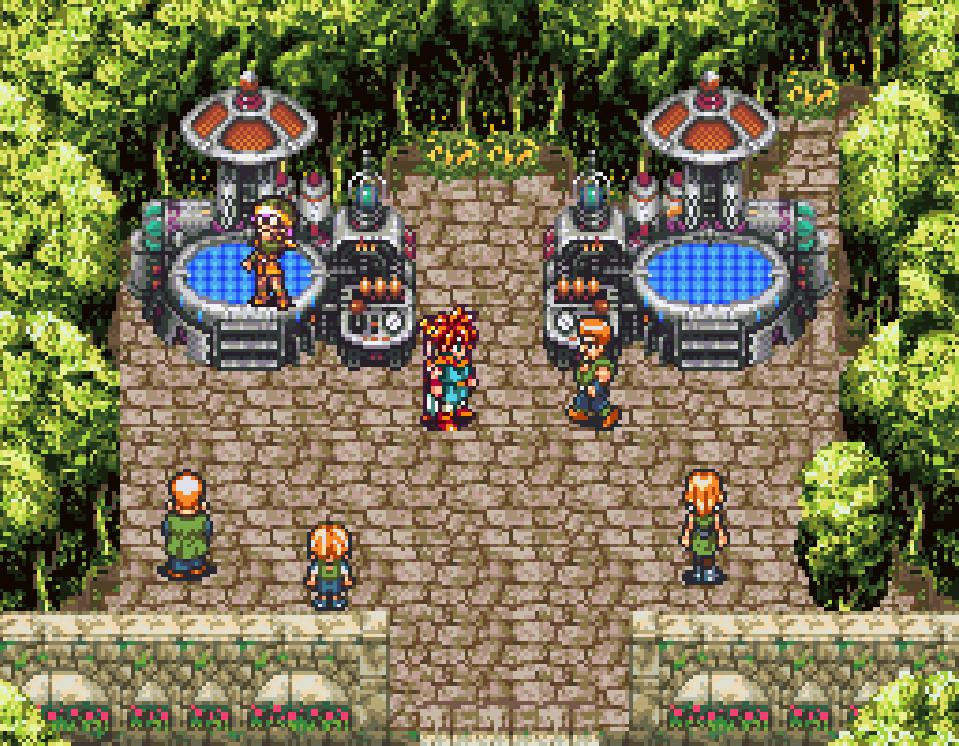
2020 was the first year I played Chrono Trigger – and, indeed, the first time I have ever played a JRPG. I had long been told that Chrono Trigger was the JRPG to play if you didn’t enjoy JRPGs, and that it had a compelling and unique story that was worth playing. Having now finished the thing, I have to say I was impressed, and I see the reasons behind a lot of the fuss that has been made over it throughout the years. The graphics are wonderful, the characters – especially Frog – compelling, the world beautifully realised, and the size and scope of the game is surprising, constantly expanding and growing as the game develops and you gradually get a better sense of the actual size of the thing. I found the battle system more compelling and varied than I had expected and the boss battles in particular were different and interesting, almost always finding some unique challenge to be overcome. Indeed, even the endlessly-repeated duplicate battles – one of the many things I have always found so intensely off-putting about JRPGs – were reasonably fun, and in sufficiently small number that I rarely became frustrated by them. It also of course has an outstanding soundtrack, while the idea of having a dozen different endings based on how “much” of the game has been completed before you go into the final battle is also original and compelling, and it’s surprising to compare this to some more recent games that would have benefitted a lot from an approach equally dedicated to really distinctive denouements. I’m really glad I experienced such a classic game, but even Chrono Trigger was right at the edge of JRPG stuff I find playable; I doubt I’ll be investigating another any time soon, but this was a great ride.
SwapBot
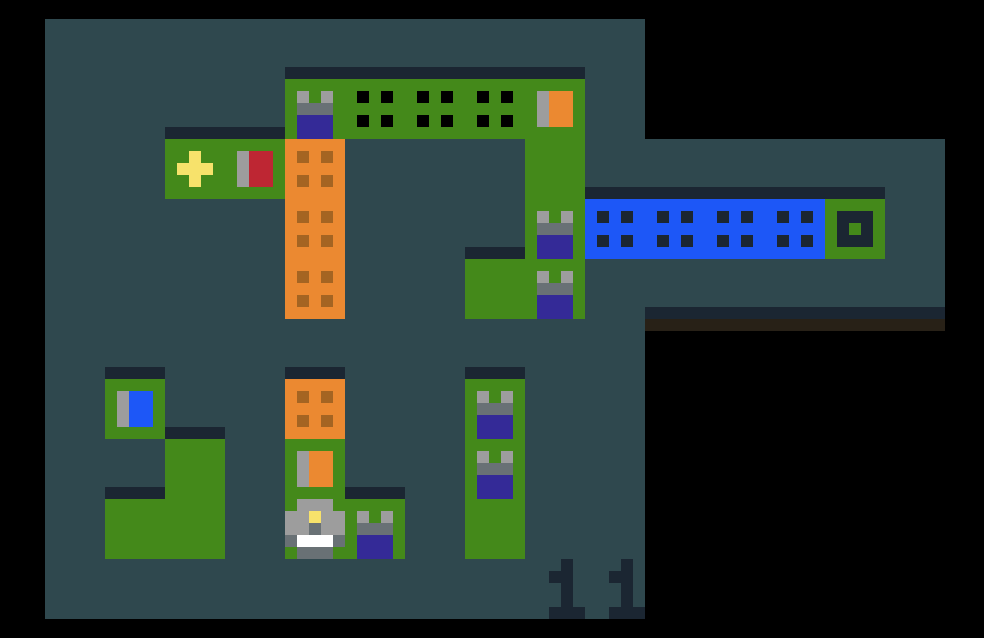
Ahhhh, SwapBot. This one is a blast from the past – during my first postdoc when I was unfortunately working for a now-notorious boss in a now-notorious “research group”, several colleagues and I played this game and we were never able to get past, if memory serves, the 7th or 8th level (and there are only 11 levels in total). Made with the totally fascinating and excellent PuzzleScript, this is an extraordinarily difficult puzzle game, despite having so few levels and so few moving pieces and mechanics. Focused around the idea of being able to transport any tile of the world onto any other tile and have the two switch around, the game’s difficulty ramps up at an incredible speed to rapidly present with you with puzzles that just don’t seem possible; when playing you often feel that with just one more swap (your swaps are limited) you could make it work. Yet sure enough there are solutions to every stage – some even have multiple solutions! – and 2020 was the year when I was finally able to complete all of them and, at long last, tick SwapBot off my list. If you really want to work your spatial reasoning muscles, this is the one for you.
Doom Eternal
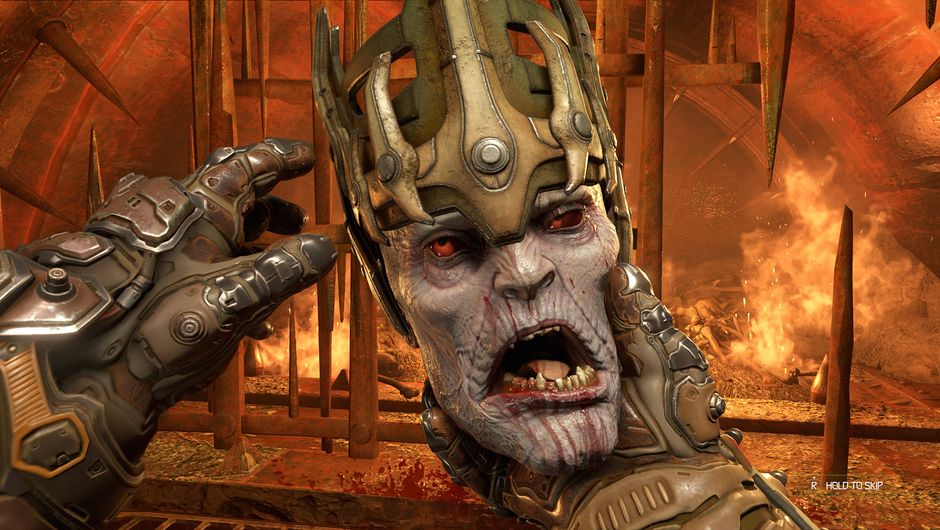
Now this was a disappointment. Doom 2016 (below) tremendously impressed me when I first played it a few years ago: an almost complete reinvention of the first-person shooter, a fabulous move away from cover, caution and moody seriousness towards speed, dynamism and almost slapstick violence. I inevitably therefore had high hopes for the sequel… but it felt me completely cold. The player jumps into the action without any explanation, clearly a lot has happened since the end of the first time, there’s no explanation about how you got from there to here, we’re suddenly killing named characters we know nothing about… I found the first hour or so to be a tremendously alienating introduction. Far too fast, too sudden, too lacking in grounding or explanation. I tried to push through it but then found even more frustration later on, centered around the fact that this game felt so much more “like a computer game” than Doom 2016; the world was full of game-like contrivances, bonus rounds, swinging levers and maces, level design that was clearly level design as opposed to world design, and a growth of a truly baffling plot (or lore?) that just didn’t make the slightest bit of sense to me. There was too much here compared to 2016, too much hyperactivity not contained and channeled through excellent world design and a clear but minimalist story. After a second attempt I just gave up; Doom Eternal is not for me.
Doom 2016 (again)
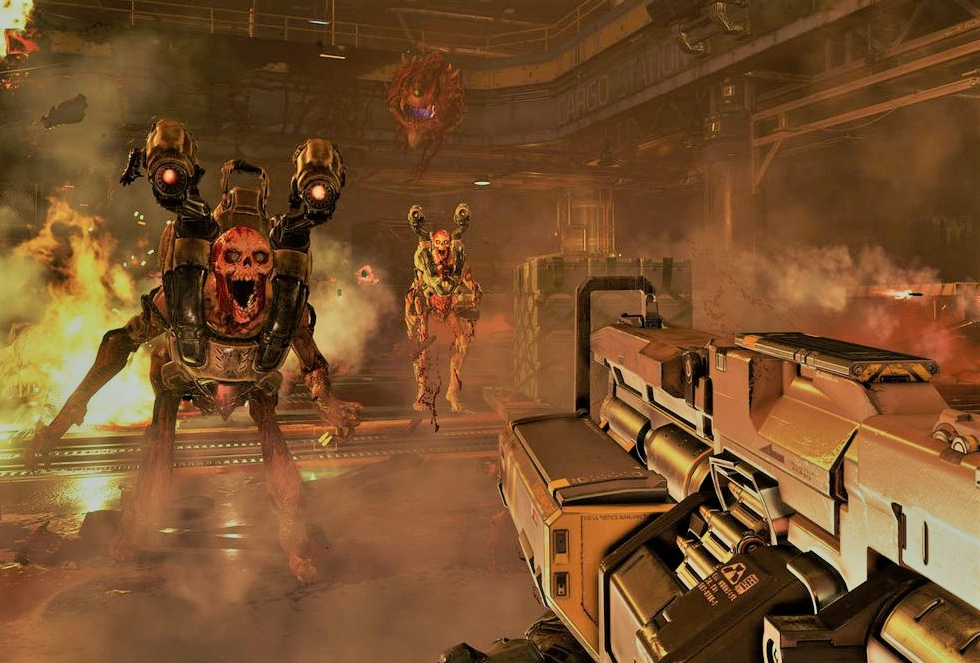
Given the above, however, I found myself excited to play Doom 2016 again! And what a game: I immediately fell in love with it once more, this time going back for the highest rather than second-highest difficulty. A solid challenge but not an absurd one (once you get that past first room with the Imps, which is a harsh wake-up call), and overall just a supremely satisfying game. Wonderful world design (both Mars and Hell), exquisite combat, an appropriate and gradual progression of abilities, and just somehow so much more grounded (!) than the sequel; this felt like a real place with real people that this insane mayhem was taking place in, rather than just a slapdash world full of semi-random elements.
However, more than the first time around I suppose I do see some of the criticisms about the second half being in many ways less compelling than the first; probably from after you kill the mid-game Cyberdemon boss. The post-Cyberdemon two levels in Hell are uninteresting and bland when contrasted against the first one (which is a startling shift in aesthetic / level design tone when you first get to it), and both are little more than a bunch of rooms with things to punch in the face. This is even more frustrating when you consider that both of them hint towards very different aesthetics, suggesting you might be moving through very different parts of Hell… and then pull back from that and settle for being quite same-y and mundane. However, I do think the later sequences once you’re back on Mars improve substantially, especially with the striking polar regions you wind up exploring, but overall I would agree with a lot of people that the second half lacked the interest, challenge and momentum of the first. Nevertheless: what a tremendous game, and what a much-needed shake-up to the genre it was (and I suspect continues to be).
Into the Breach
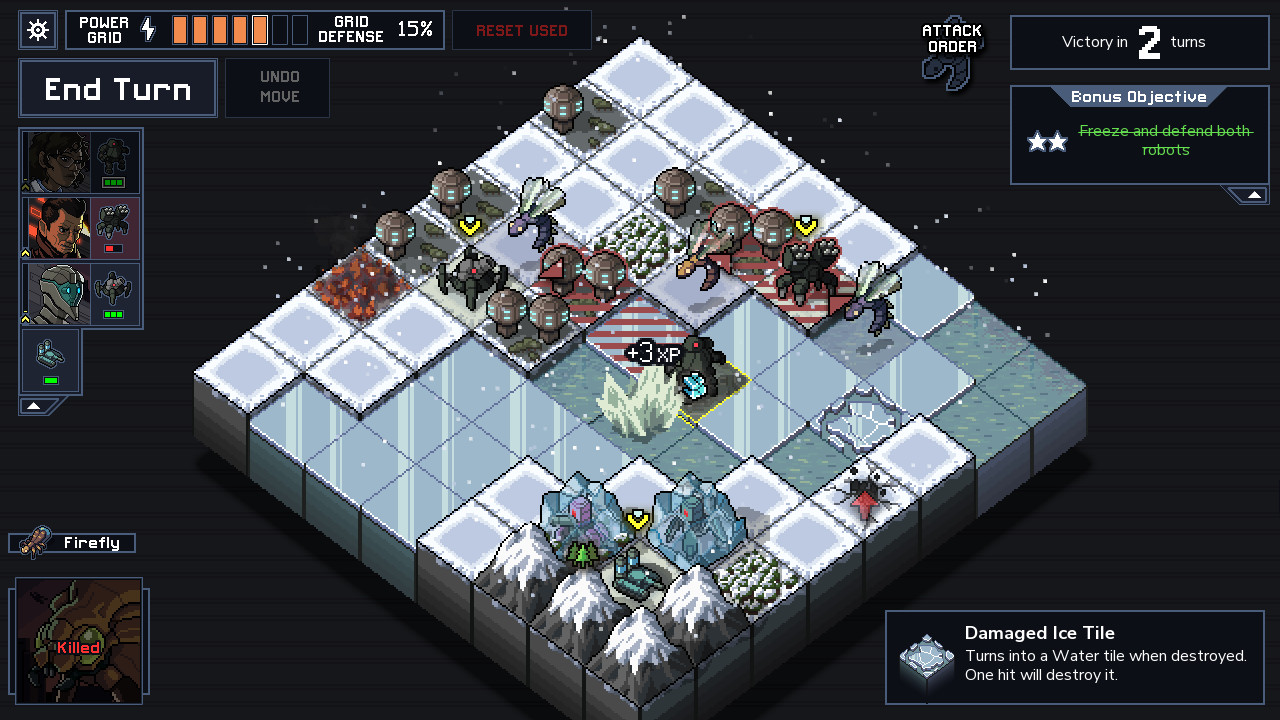
FTL is probably my favourite modern roguelike; infinitely replayable, with gorgeous graphics, a great soundtrack and a high difficulty level on Hard mode, it’s a tremendous piece of work. Unlike Doom Eternal, this “sequel” (loosely speaking) did not disappoint. You control up to three giant mecha to fight off an invasion of giant insects; each mech has a different set of abilities and movement capabilities, and more can be gained or sold off during each playthrough. In a sense the game is akin to a procedurally-generated puzzle; the maps are lightly generated and then each turn the player controls a number of pieces to evade or block the attacks of enemy units, and in the process protect important buildings or objectives on the map. There’s a lot of different layers going on here – positioning, movement, damage, pushing, smoke, fire, water, acid, and others – and they integrate extremely well and with surprising clarity thanks to the detail about future movements and key game mechanics the user interface offers. This is one of those rare modern roguelike-y games I have “completed” in the sense of completing every mech team, every difficulty, and even a challenge run involving three Hook Mechs (by far the most useless in the game) on Hard mode – that was a tough one. As part of this I must also express my appreciation for the achievements in this game, which I felt were exactly what achievements should be – unobtrusive, nicely integrated into the game, and able to provide interesting “challenge runs” without forcing players to focus on them before mastering the game’s basics. Overall I thought this was a great and worthy sequel to FTL, albeit I think with a little less replay value. The guys at Subset Games continue to impress and I can’t wait to see what they do next.
Supreme Commander
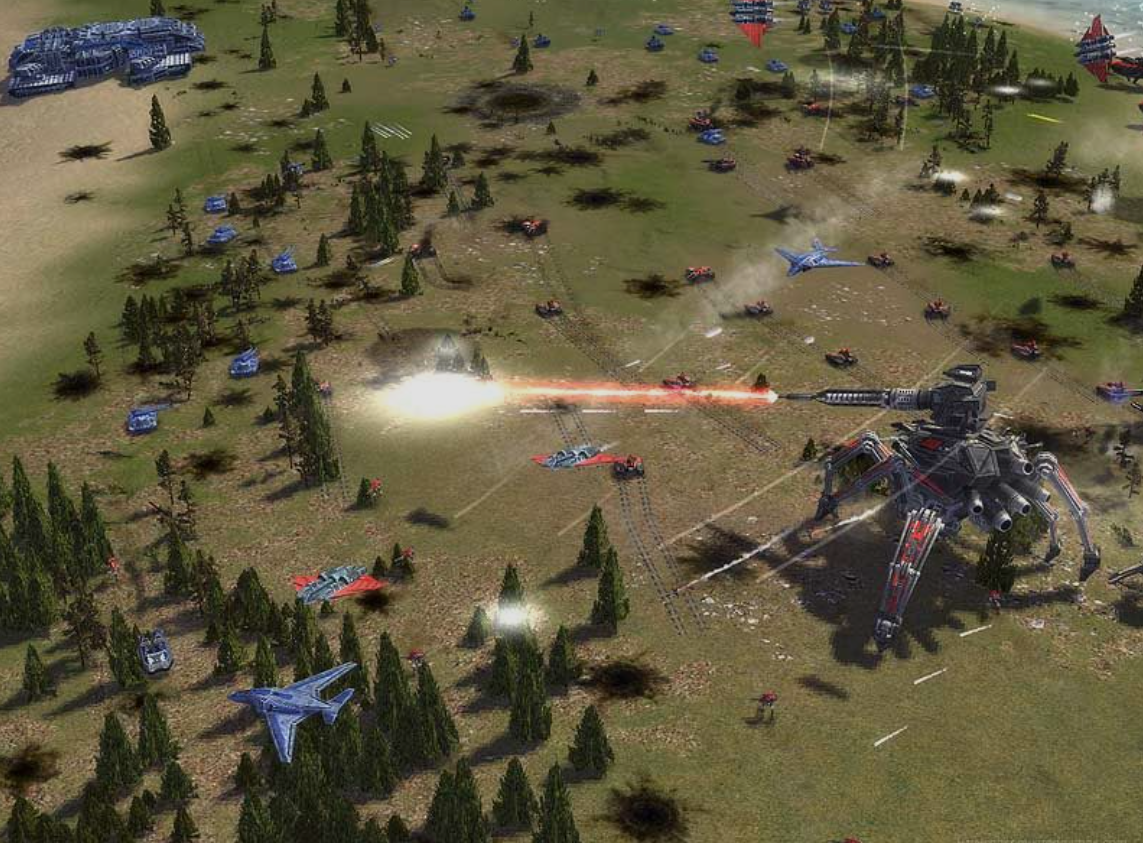
This is a game I’ve been wanting to play for a long time. I’ve been a fan of the RTS since my earliest days playing Command and Conquer when I was seven years old on a PC bought specifically for that single exact game, and I’ve been long saddened by the decline of the genre both in terms of its gradual slip into becoming MOBA games (which I find dreadfully dull) and the tremendous (over)emphasis on multiplayer over singleplayer RTS gaming (StarCraft II, for example). The trailers and YouTube videos I’d seen of it looked tremendously impressive… but although I gave it a good try, and although the scale and scope of battles is a gripping selling-point, it just didn’t do it for me. I think the main issue was that none of the three factions stood out to me as really having much in the way of personality (compare to GDI and Nod from the more “serious” side of the Command & Conquer series, or indeed the Allies and the Soviets from the far more zany and chaotic Red Alert sub-series; or the Protoss, Terran and Zerg from StarCraft) and this impression was strengthened because so many of the units are almost perfect duplicates of other units. The factions themselves are also very “generic SF” compared to what one sees in some other games and there just wasn’t anything that pulled me into this world, which seemed very archetypal and lacking in any real creative spark.
Equally, as far as I could tell, this commonality or banality seems to apply to gameplay differences at least to some extent as well as thematic or aesthetic elements. Every faction has an air-to-air interceptor, every faction has a light tank, every faction a medium tank, every faction a heavy tank, every faction a ground-to-air vehicle, every weapon an air-to-sea plane; and so on and so on. Even the tech trees seem to be near-identical, with all three factions having the same three basic factories (ground, air, sea), the same buildings for gathering resources and defending bases, and so forth. In other RTS games we of course see some commonalities in the buildings the factions produce – if your game is going to have a “power” system like C&C does, then all factions are most likely going to end up having “power plants” or some equivalent – yet we also see very divergent tech trees as well and units which do not have obvious equivalents in other factions. This difference – maybe one faction has a great air-to-ground unit, but the other faction doesn’t but has a great air-to-air unit – are surely the things that generate interesting asymmetric battles. Think also about things like creep for the Zerg, pylons for the Protoss, the ability to move buildings for the Terran – these are deep and profound differences in how each faction builds, spreads, defends, and so forth. At the end of the day I just didn’t feel this was a game that was going to reward the time I was thinking about putting into it. Perhaps if I had come to it I was 15 or 18 and playing RTS games every second of the day it might have been more successful, but I don’t think this is for me any more; the world didn’t grab me, and however compelling the gameplay might be, I was lost after that.
Antichamber
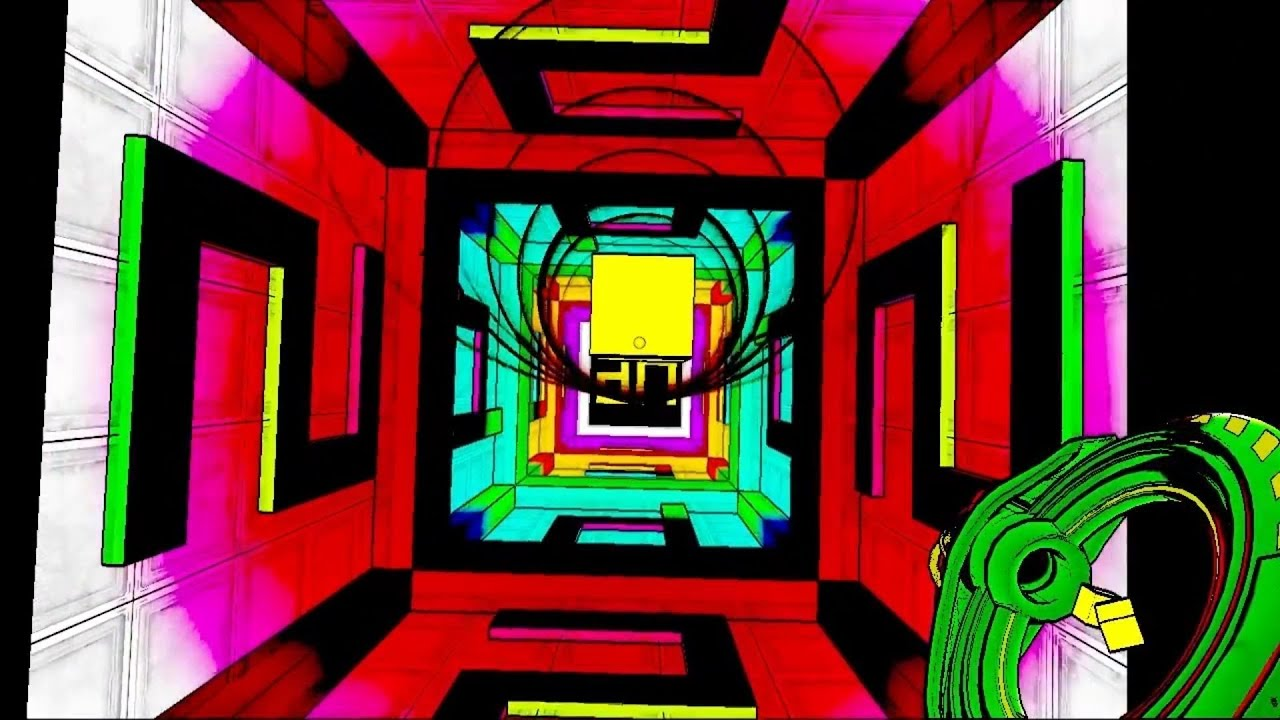
I’ve been on quite a puzzle game kick lately (as you’ll see from this list) having become recently interested in puzzle design, and in my wanderings around Steam I remembered about Antichamber. I think I played the first 50% or so soon after it came out, but then I lost interest – if I recall, this was due to some of the more cryptic puzzles in the game. I think cryptic puzzles can be very interesting and compelling, and games like Antichamber or La Mulana have some good ones, but they can also – as (sadly) in The Witness (see below) – descend into a “guess what the designer’s thinking” contest, which is not especially compelling. Here this is intensified because the world map is strangely unhelpful and doesn’t seem to particularly usefully convey where I have exhausted, where new options awaited, and what permutations or moves on my part might open up those new passageways. I also found it intensely frustrating when you would sometimes attempt a puzzle, render it impossible through error (this is called “cooking” a puzzle, I think?), and then rather than being able to quickly restart, you had to return to the hub area, find the place you just were again on the map, and click it in order to return and try once more. Some kind of puzzle-limited “reset” option would not have gone amiss. Nevertheless the main body of puzzles, i.e. doing things with the cube-placing / cube-moving gun, were generally interesting and tricky, although a few too many puzzles were a little too similar for my tastes (fill out a shape with cubes) while others were so unlike anything else that from time to time I felt the game hadn’t adequately prepared me for a particular challenge. Equally, some were very subtle and clever, while others – such as jumping up and down on a platform to build momentum until you could push the platform sufficiently far down or have it rebound sufficiently far up – felt oddly banal. I also found myself being frustrated at having to “find” new puzzles to do (see my thoughts on The Witness below) and sometimes being unclear what was a dead-end, what was a puzzle, what puzzles I had finished, etc. As a result I – for the third and final time! – failed to get past around 50% of the way into the game, and I don’t think I’ll be going back again. There’s some great stuff here, but it really needed more focus and direction for my tastes – an absence of direction is great in many games (your Souls-like games, your Metroidvanias, etc) but I increasingly find that in puzzle games I just want to do the puzzles.
Recursed
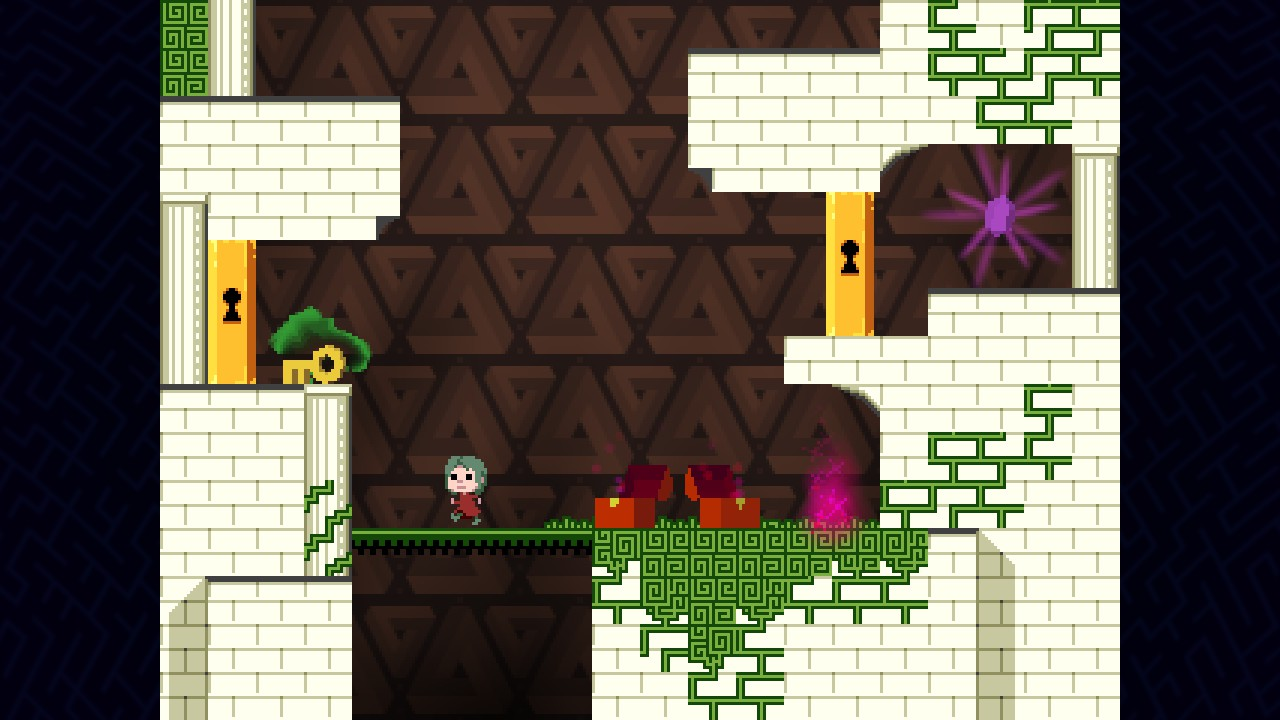
This was a fun little puzzle game! The central mechanic involves you being able to jump into chests, each of which contains a level or a bit of the world, and place chests in other chests, thereby manipulating the entrances and exits from these various worlds in interesting ways. This was a cool central mechanic and the opening puzzles were definitely interesting and set up a number of surprising interactions with the fairly simple pieces. However, I confess I lost interest about 10 or 12 levels in – the first set of levels had grabbed my interest and done some cool stuff with the core idea, but the game didn’t seem to be adding in new ideas at a sufficient rate (or sometimes at all) – many levels felt somewhat comparable to other levels, and the same sorts of logic tended to get you through. Nevertheless I appreciate the innovation in the core idea, and this was definitely worth a few hours of play.
Doki Doki Literature Club
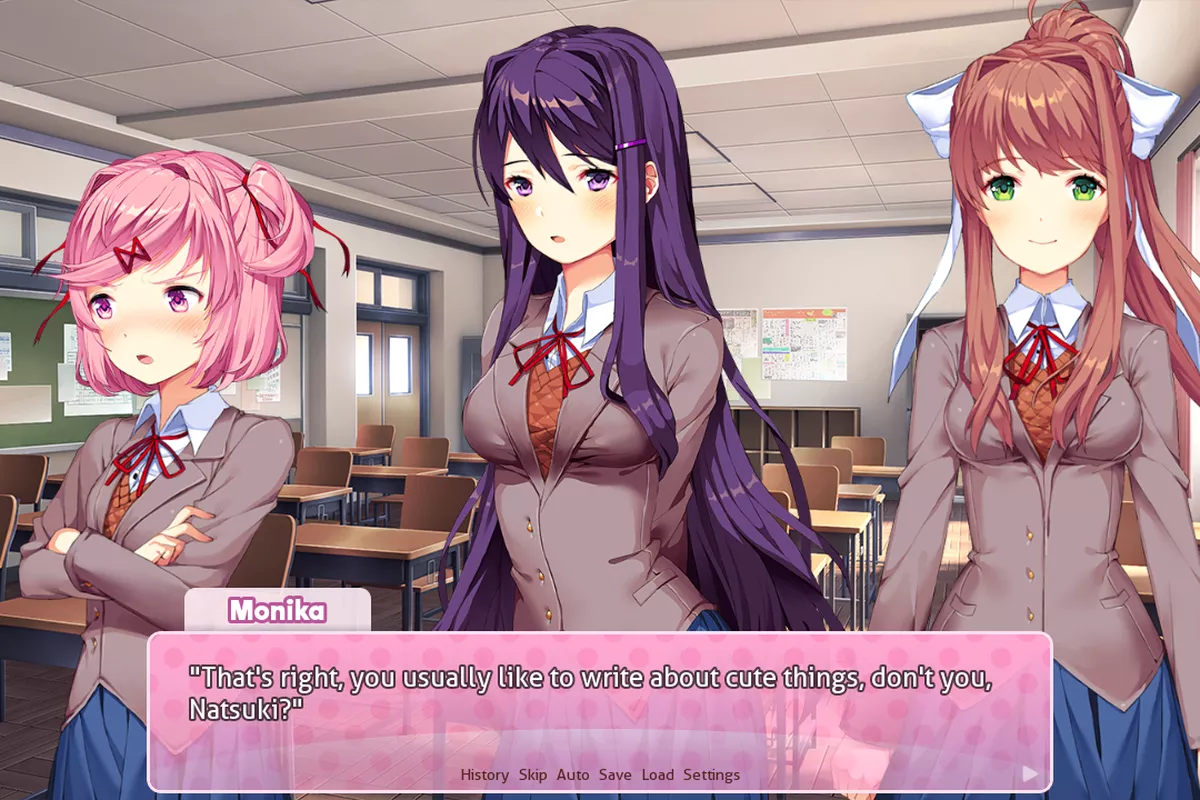
Doki Doki Literature Club really blew me away. It’s a very entertaining visual novel, a very effective horror games and fourth-wall-breaking game, and on top of all that a surprisingly affecting look at adolescent romance / obsession, mental illness, suicide, loneliness, abuse, and lots of other stuff too. This one really stuck with me for a while. I have since been informed by people who know more than I do about the visual novel / dating sim genres (and their parodies) that a few somewhat comparable ideas had actually been used in earlier games, but this remains the first I personally have come across them – and, having now looked at some of these other perhaps slightly more obscure games that may well have inspired DDLC, I don’t think they would have had the same emotional effect on me that this particular game did. The game’s themes resonated with me particularly strongly, and the writing was (I thought) of a very high calibre.
The Witness
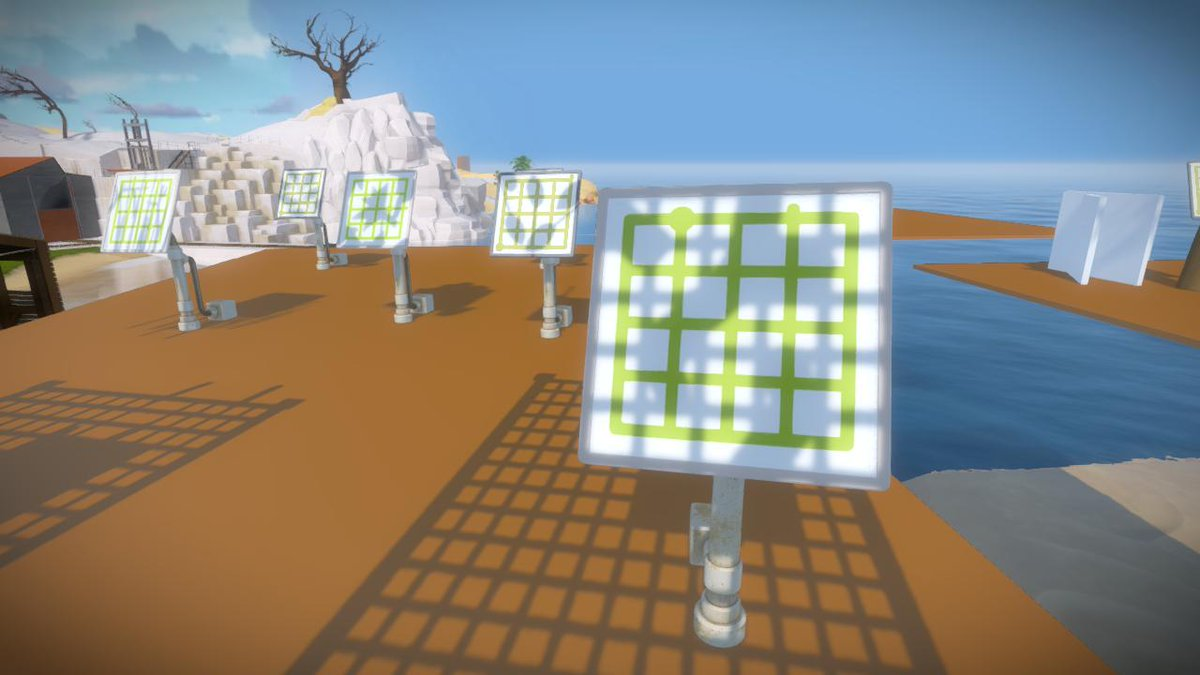
This was another disappointment for me this year. I think Braid is an outstanding piece of work, but The Witness just didn’t do what I’m looking for in puzzle games. I played it for about 3 hours, rage-quit at the end, and haven’t gone back. The core puzzles themselves, i.e. the grids, I found very compelling and enjoyable. Not to the extent of some other puzzle types, e.g. Sudoku or Skyscrapers or even crosswords, but I found them interesting, new, nicely designed, and from what I got in my first three hours (30 grids, perhaps?) new elements were being added at a good pace and I could see how these were going to add up into increasingly complex puzzles as time went by. All good so far. But the problem was that absolutely everything outside those core puzzles I truly couldn’t stand. I found the island visually uninteresting and didn’t find myself at all inclined to explore; I found the process of searching for more puzzles extremely frustrating because I wanted to be doing the puzzles instead of wandering around looking for them; I also found the environmental puzzles to be very much just “guess what the designer was thinking” puzzles rather than anything that could be deduced, and that frustrated me. So I found all the wandering and all the stuff in between the puzzles annoying, but I stuck with it until I got into a little boat on the edge of the island. I clicked a button to see what it did… and the boat closed, I couldn’t escape, and – in a game that had already bored and frustrated me with the lack of stuff to do – trapped me in a three-minute ride back to where I started. That was the last straw for me – immediate closed the game and I haven’t looked back.
Now, I have since checked out some of the later puzzles on YouTube, and they look tremendous. If only the game had just been a sequence of puzzles without all the other stuff I would have absolutely fallen in love with it, but this emphasis on seeking out puzzles rather than completing them was just too frustrating for me. (And this should not of course be read as “Things must be trivial or I quit” – see my thoughts on Rain World below. This was a more specific thing tethered to the structure of this game, what I expected from it, and what it gave me). Overall I’m glad I gave it a shot and there’s clearly a lot of wonderful puzzles here, but everything “around” the puzzles themselves left me completely cold.
Escape Goat
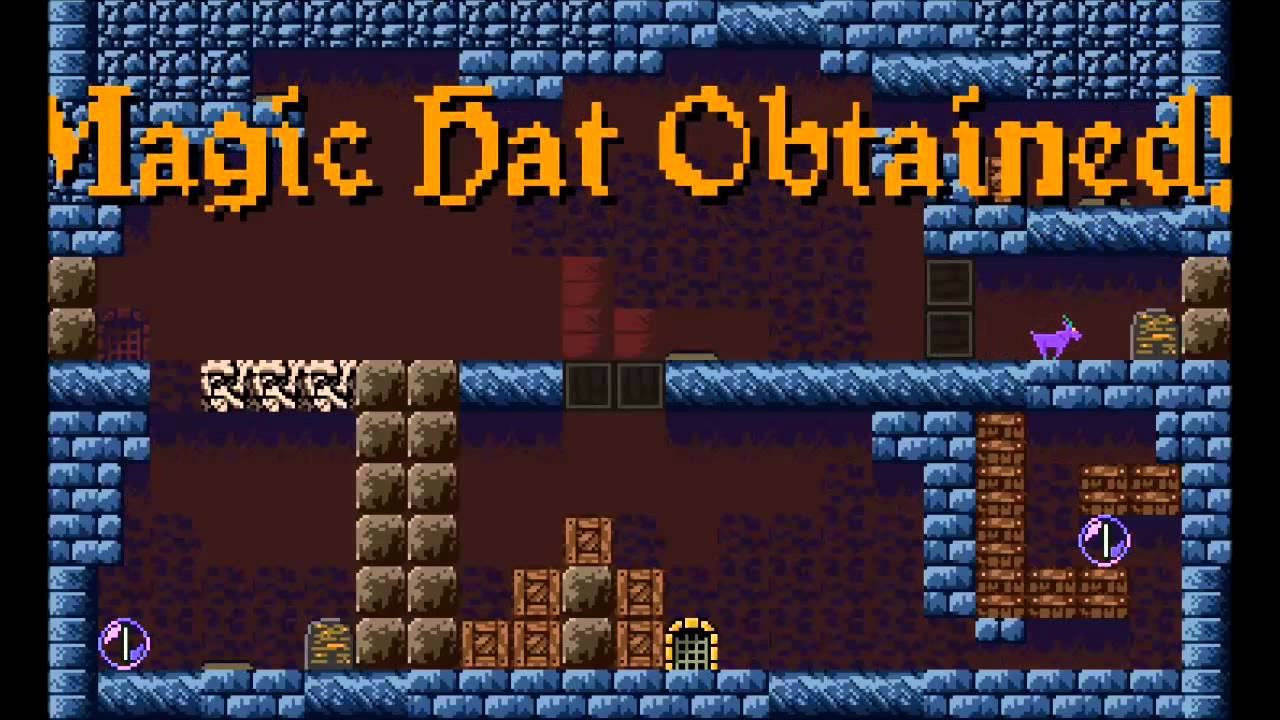
Despite being far simpler and less ambitious than The Witness (neither of which is a criticism) this charming little puzzle game did far more for me this year than its blockbuster cousin. By controlling a goat – and its magical mouse friend – you are tasked with finding your way through several dozen puzzle levels, often quite tricky, and sometimes requiring some reasonably sharp platforming as well as puzzle ability. The visuals were charming and the music a particularly strong note for the game; overall it had its thing to do, did it, and didn’t overstay its welcome.
That said though, some of the puzzles in Escape Goat weren’t, I thought, really puzzles; they were more to do with carrying out a bunch of quite clear steps in a complex mechanism in order to make your way to the exit. Several stages were like this and never presented me with uncertainty or difficulty – not because I’m claiming that my puzzle-solving brain is unusually sharp, but simply because these levels didn’t really have much to do in them except the right moves. There was a real elegance to the complexity and the interactions in some of these “mechanism levels” but they weren’t really puzzles at all. These didn’t do a great deal for me; and similarly a handful of late-game levels were much more like platforming levels then puzzles, and while I obviously have nothing against a good platformer, it wasn’t really what I was looking for here.
Alpha Centauri
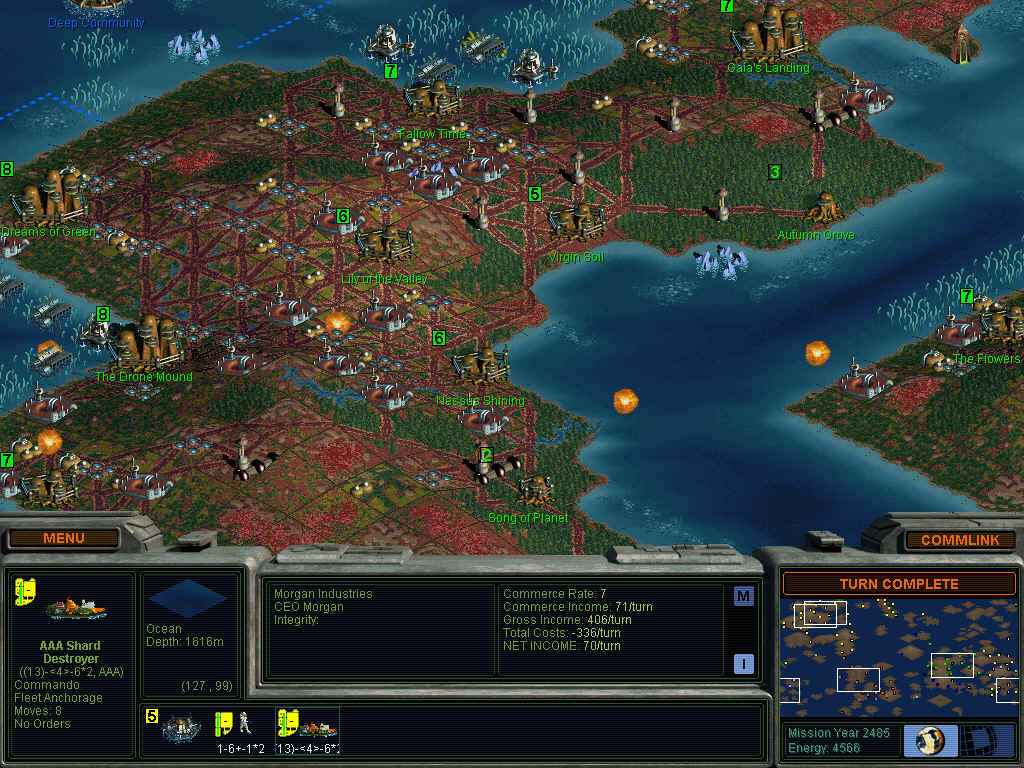
After a bunch of new games I thought the time had come to return to an old classic: still by far the best SF strategy game ever made, maybe the best turn-based strategy game of any sort, Alpha Centauri still stands tall after all this time. As one of those games I exhausted a long time ago (or thought I had) it needed something new this time, and I realised that I had never actually played it properly with the alien “Progenitor” factions active. I’d heard somewhere that they were just too overpowered – but I now discover there’s a host of new dialogue and new “Book of Planet” narrative entries to accompany them, which has been a real pleasure to go through! Some fabulous writing and really interesting depictions of this extremely alien culture and their perception of the human arrivals. Very good stuff – yet another layer to a game I long ago thought I’d squeezed every bit of value out of.
Cyberpunk 2077
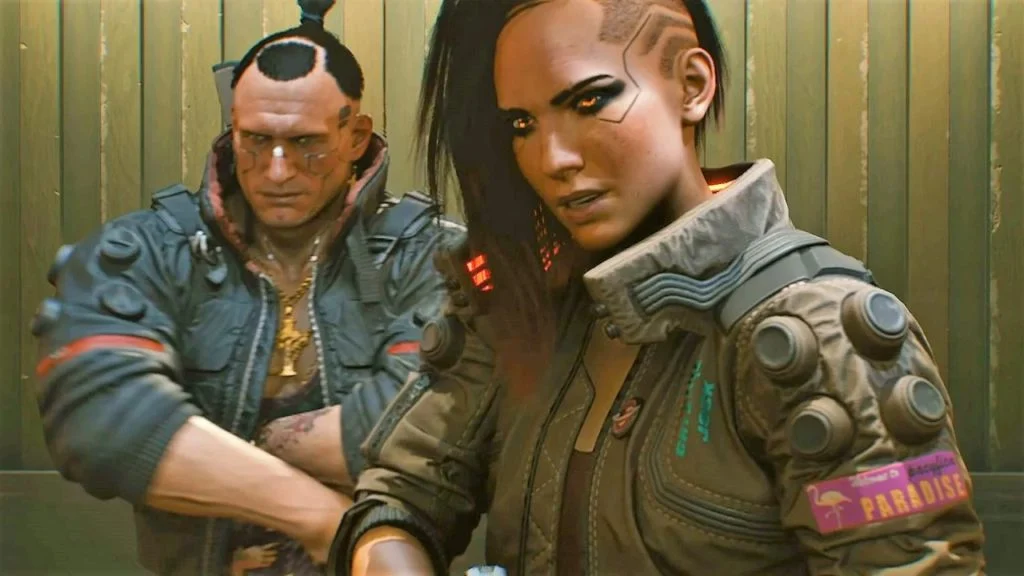
Now: Cyberpunk. I’m not going to talk about the glitches and bugs – which are ridiculous – but rather about the game as intended. Despite being a strong fan of cyberpunk as a genre, I was unimpressed with Cyberpunk 2077 from pretty much the moment that any gameplay trailers appeared. I thought it looked very slick but very surface and probably lacking in much depth, and far too punk and insufficiently cyber – it felt like the kind of cyberpunk that Neal Stephenson tacitly makes fun of in Snow Crash, for instance. As such, I don’t say this to brag about my astonishing prescience (I’m wrong about upcoming games as much as anyone!) but having now experienced the full thing, in this particular case my initial read remained how I felt. From the get-go the game looked surprisingly flat, surprisingly lacking in organic interactions between characters, and it looked like one of those game worlds which appears to be stunningly detailed but actually has remarkably little to do in it. The world seemed to me like such a disappointment – William Gibson’s earlier critique of the game, that it’s just “GTA skinned-over with a generic 80s retro-future”, really strikes true. Night City seems to just be a normal city with some neon and some funky fashions. Compare it, for instance, to something like the world of Blade Runner 2049 – that’s a fundamentally new world, one extrapolated from where we live now but so fundamentally different, restructured at every level from the top to the bottom. The Cyberpunk 2077 world is just our world, albeit with some funky body-mods and neon: a real shame, and not something I feel a desire to play through to completion.
(However, I must give credit to the memory-rewinding mechanic – that’s very interesting and compelling, and one of the few bits of cyber the game actually seemed to have).
Among Us
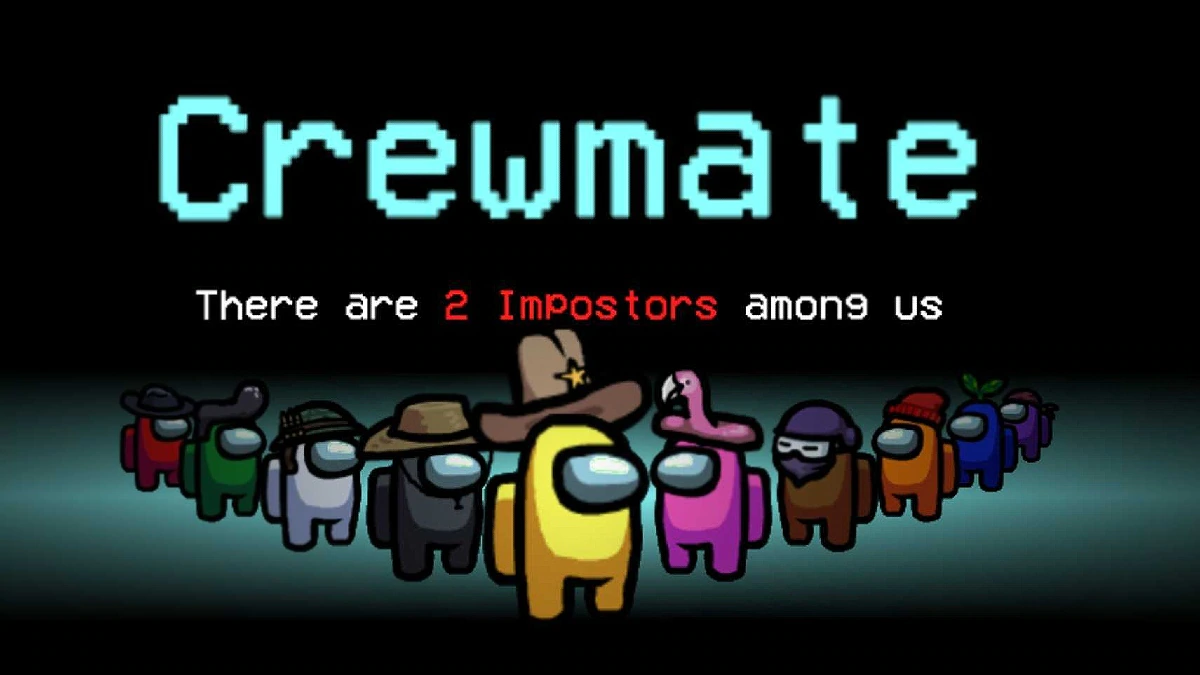
Entirely delightful.
Pony Island
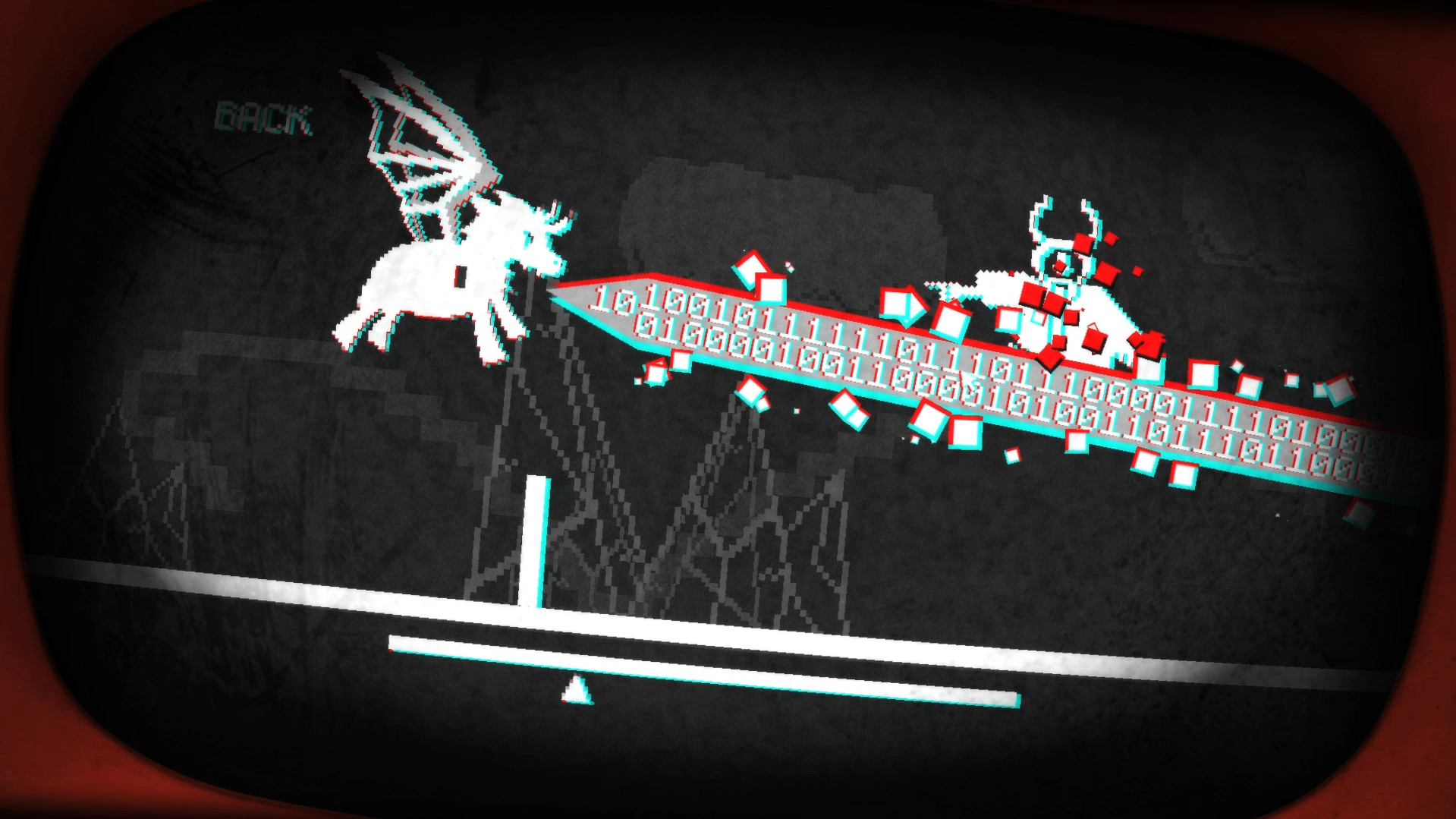
I’d heard good things about this game as being one of those fourth-wall-y surprising or meta-fiction-y games, and although I went into it with at least a loose idea of the basic thing (a cutesy pony game turns out to be infected by demons, or viruses, or something, which you have to fight off?) I really enjoyed a lot of the stuff the game brought to the table. Throughout there were plenty of weird sequences where you felt like you were fighting against the game’s user interface, or fighting a malicious force within the game, and trying to find ways to navigate this strange environment where so many of a normal game’s non-diegetic elements (menus and the like) suddenly took on new meaning. The graphical style is also very distinctive and pleasing, and both the run-and-gun elements and the programming-esque puzzle elements are well-developed and thoughtful, and continue to ramp up in difficulty and complexity as the game progresses. I haven’t quite finished it yet but I think I’m close to the conclusion, and I do intend to go back and see the whole thing through. As with many games of this sort it hovers on that margin between “being smart” and “trying to hard to be smart”, but I definitely think this one landed in the former category rather than the latter. I believe the developer has since released another game, The Hex, which I anticipate checking out at some point in the near future.
Rain World
Now then.
More than any of the above…
…we need to talk about Rain World.
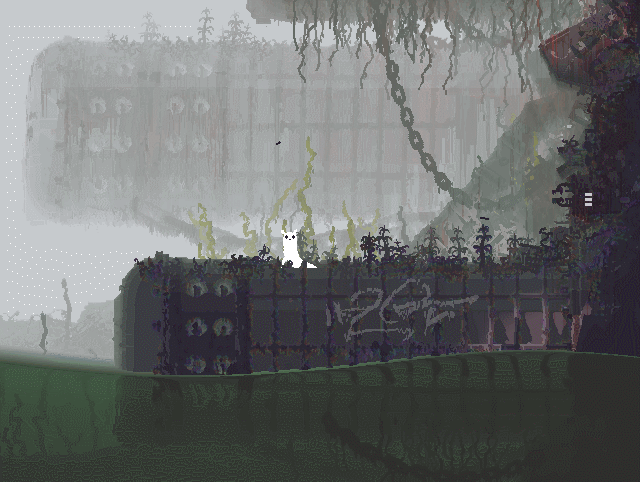
This game actually has a bit of history for me – back when I was actively posting URRpdates on the TIGSource forums I remember vividly seeing a development thread for this game, and the immense amount of excitement it was generating with its fluid movement, beautiful pixel art graphics, and captivating creatures and emergent ecosystem relationships and interactions. I confess that I didn’t quite notice when it came out – although I now notice its release date and update schedule coincided with what was perhaps the absolute maximum intensity of my postdoc academic life, i.e. 2017 and 2018 – but I came back across it on Steam over a year ago, bought it on a sale, and (as we so often do) promptly forgot about it. A couple of months ago while beginning to put those final touches to URR I noticed it again on my Steam list, remembered how captivating it had seemed, and gave it a play.
I… was not disappointed.

In Rain World you control a little “slugcat” (essentially a kind of slinky ferret creature) who has been separated from its family and must find its way back to them. The world is vast at over 1600 (!) screens split into about a dozen different areas, and the world is filled with dozens of fascinating creatures (and plants, some of which are carnivorous) which all interact whether the player is present or not. Some are hunters, some are hunted, some – like the slugcat – are both, and what makes the world so mesmerising is seeing this ecosystem behaving around you. At times you might take part in it but at other times you hide, or try to lure a more dangerous creature to take out a less dangerous creature blocking your path; many of the creatures and plants have very complex sets of behaviours, especially the “scavengers”, the other “intelligent” species in the wasteland. The scavengers merit a full discussion although I don’t want to spoil too much, but they (like many other creatures to a lesser extent) are complex artificial intelligences with intriguing social and individual actions and motivations. Getting to know them, and finally figuring out to trade with them after exchanging wordless symbols and gestures, was absolutely gripping. For anyone of an anthropological bent this element of the game is uniquely compelling, and for anyone of an ecological bent the entire thing is absolutely captivating.
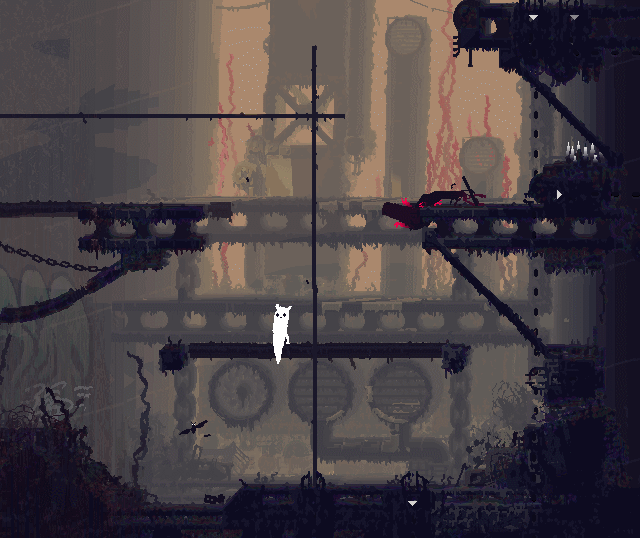
In turn, the first time I saw each new creature – I’ve spoiled very few here in these gifs – was such a magical, transformative moment. It felt like stumbling into a foreign land after a year abroad a sailing vessel and you are suddenly assaulted with the sights and sounds and sensations of the new: a completely virgin ecosystem never before seen by (your culture’s) eyes, a world that has its own set of rules and practices and logics of which you are currently completely ignorant: but with time and patience and experimentation you can come to understand how all the creatures and plants act, how they act around you and each other, and how you can potentially use (or evade) them in order to traverse the world. (On this note I should say the controls are extremely unusual since this is a physics-based game, and while they really take some getting used to, after 5 or 10 hours I had gone from basic control to a high level of precision, and that was very rewarding). Additionally, most of the creatures are so fearsome and death so brutal that you really come to fear the predators of Rain World, and what this means is that the first time you ever manage to slay a predator, the feeling of victory is intense, and one of the most rewarding things I’ve had in a game in a while. It took me about 10 hours to slay my first lizard, and about 20 hours to slay my first vulture (I was completely unspoiled by the wiki, I must stress: I recognise at least the first of these was probably not as hard as it seemed), and when I did, my cry of victory was surely heard all over Sydney. It’s a fabulous moment, and one only possible as a result of the psychological weight the predators adopt after hours and hours of ducking, dodging, weaving, evading – and sometimes being eaten.
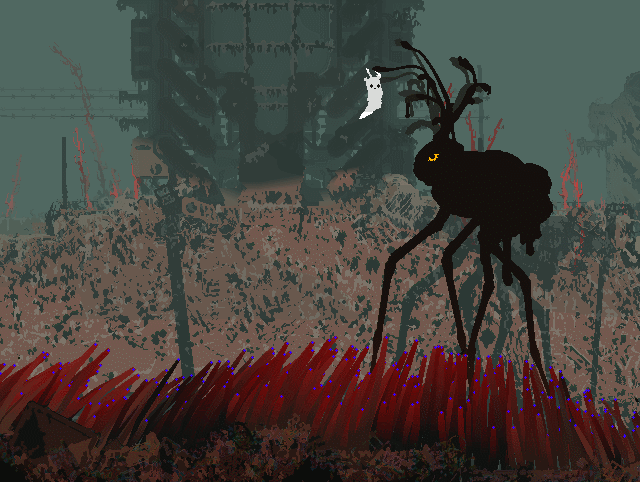
However: all is not perfect in the glorious living ecosystem of Rain World. There is one fundamental problem with this game, and one which almost all game critics noted: the punishment for death is extreme. This is not a permadeath game, yet in some ways the punishment is almost “stronger”. Consider a From Software game: when you die you leave a “bloodstain” or equivalent, and if you get back to there again on your next life, having restarted from a checkpoint, you will regain everything you had on that previous life; if you die again, the bloodstain is lost. I think a lot of people (myself included) think this is a first-rate system for hard, (semi-open-world), exploration-focused RPGs / metroidvanias; it’s harsh but not too harsh, gives a wonderful risk-reward tradeoff both on any given life and the life immediately subsequent to it, and encourages exploring while also allowing you to play it safe and build on what you’ve already done. Rain World basically takes this system, but upon death removes the bloodstain (so you always irretrievably lose whatever “souls”-equivalent, in this case food, you’ve acquired), deletes from your inventory any item you collected on that life, and – there’s no perfect Dark Souls comparison here, but I’ll try – reduces all your stats, permanently. This is just too damned much, frankly, especially because your “stats” come to matter when moving from one area to another; you must have had a sufficient number of death-free lives almost in a row in order to move from one area to another, which generally means you just have to farm in order to move from X to Y; there is no way to get around this. This sucks, dreadfully, and simply off the top of my head I could think of so many ways this could have been done better – harsh, but not just unduly punishing to the player, especially in a game about exploration and a game where you die in one hit from any hostile creature!
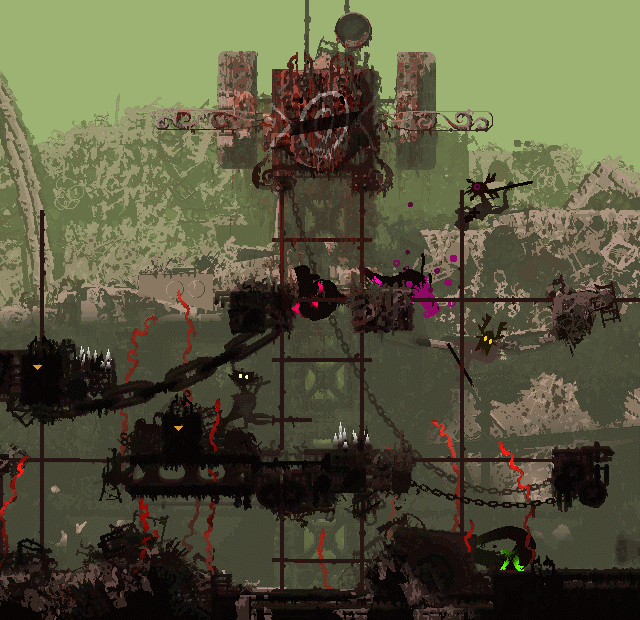
Additionally, the ending… is… just nonsense. Weird, gibberish, nonsense. It’s like the ending to a different (and far worse) game; it just made no sense. I want to stress this in the strongest possible terms: this is the Lost Season 6, or the Dexter Season 8, of computer game endings. I couldn’t quite believe what I was seeing; it was slow, boring, baffling, bizarre, completely unrelated to the rest of the game, gave no closure about the main plot, and turned the slugcat into some kind of weird metaphor for a sperm entering an egg and thus creating life? What is going on?! I confess this wretched conclusion left a really negative feeling in me after such a gripping and fascinating game, but I then quickly went back into the main game for an hour or two and immediately was reminded of what I’d found so compelling: these fascinating, unexpected, emergent moments, and the joy and relief of finding a new shelter and successfully hibernating after a grueling battle for food and survival in the wasteland. The process of playing for my 35 hours was magical and deeply memorable, even if the ending was just a wet raspberry noise at the end of a magnificent stirring symphony.
Anyway: despite the above I cannot recommend Rain World enough: a stunning, unique game, with moments of amazing emergent events I will never forget. However, should you choose to play it, I encourage you to either a) play on the “Monk” difficulty which reduces a LOT of the frustrating parts of the world gating (although at the cost of making the world far more peaceful), or b) do what I do and play on the “Survivor” difficulty (the standard one) but be willing to sometimes save-scum when you’re trying to get into or through a gate, or you have just gone through one. I have no regrets about save-scumming this one; there is no way I would have continued the game past about 5+ hours had I not, and that would have meant missing out on so much incredible stuff. This game wants you to explore and experiment, yet punishes you more than perhaps any other game I’ve ever played; in my view, if you want the best Rain World experience, you need to find a way around it. There’s something beautiful and masterful and unique and incredible here, but a little bit of work is required to really make it shine. Once you have it though, shine it truly does: the sense of discovery, experimentation, and serendipity, is just exquisite, and like nothing I’ve ever played.
2020 -> 2021
So: there we go! I played some games in 2020 and had thoughts on them. What did you all play? Any of the games I played? Anything you think I ought to play? Let me know below!
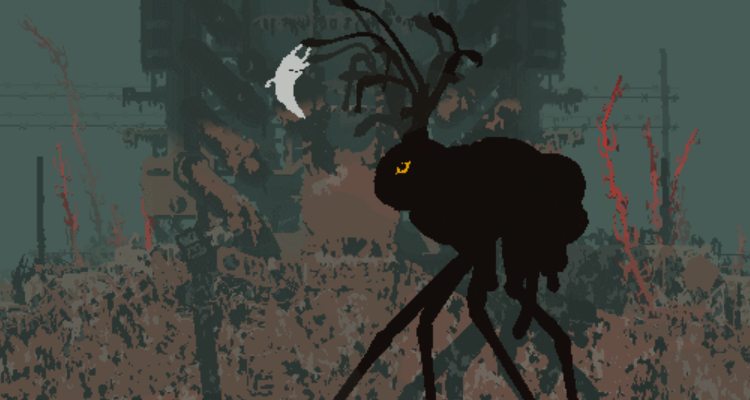
Regarding Rainworld, have you any opinions on the monk and hunter characters?
A good question! Honestly I think the “perfect” Rain World character would actually be a combination of all three – the relaxed karma requirements of the Monk, the enemy volume and hostility of the Survivor, and the speed of the Hunter. I played as Survivor, and it’s not impossible I’ll one day go back and try to win a game as the Hunter, but we’ll have to see. I think it’s good they are there, but I think a more polished character design could have integrated all three into the ultimate slugcat.
For puzzle game recommendations, I would highly suggest the Hexcells trilogy. They’re a little more math Sudoku-ish style than platformer-ish puzzlers like most of those you’ve posted here, but they’ll stretch your noggin for those rewarding AHA moments of dopamine satisfaction like few games. Also The Return of the Obra Dinn is in a class of its own for similar reasons.
Hexcells? Thanks for the recommendation! I somehow forgot to mention in this post that I’ve actually been playing a lot of handmade custom-rules sudoku this year (of the sort one sees on “Cracking the Cryptic”); maybe I’ll do a separate post about that. I have also heard good things about TRotOD – my only fear is that as I continue to return to screenwork post-concussion it might make my eyes go weird, but we’ll see…
Hmm okay. In that case, I also have a condition that can give me dizziness and motion sickness if I’m not careful with FPS movement in certain games, and I remember Obra Dinn did trigger that a couple of times, so might be better holding off until you’re fully recovered. Then again, if you were okay with Doom’s pace then YMMV.
Interesting! I appreciate the thoughts – it’s definitely on my list of games to try :).
Mark, have you played Outer Wilds? I cannot recommend it enough, and based on your writings here I really think you’d like it.
If you have not played it please do not look up anything about it. It is best experienced entirely unspoiled. It’s an environmental story/puzzle game told in a miniature solar system that you explore (basic Newtonian physics apply)
Tim, great minds think alike – I am actually playing Outer Wilds at the moment! I am enjoying it tremendously, it’s excellent. It captures everything good about those old “hunt the pixel” or “guess what items to combine” adventure games while getting rid of all the rubbish arbitrary and guess-what-the-designer-is-thinking moments. I’ll be writing about that in my 2021 roundup in 11 months time :).
Thanks for the reminder about Alpha Centauri! It may still be my favorite strategy game of all time. Should reinstall it one of these days. If you haven’t already seen it, Paean to SMAC is a fun way to spend an afternoon. Someone went through all the datalink entries and wrote about what each of them has to say about the game setting’s history and philosophy. https://paeantosmac.wordpress.com/
Oh wow, Paul, thank you for a link to this – this seems like EXACTLY my kind of thing…!
What is that The Witness screenshot? I know the island well, and that place categorically does not exist. Did you play a tech demo by mistake or something?
Anyway, I definitely recommend that you give it another chance. As far being trapped in the boat — you can control it while you’re in there by interacting with the map.
Haha, that’s interesting! I just Googled “The Witness” and found a pic that I felt was suitable. Gosh, maybe it was from an earlier version – whoops! Re: the boat, I am sure I tried to do that but nothing happened, so maybe I was being incompetent. It… is not impossible that I will give it another try some time, but there’s so many other games out there which haven’t yet left a bad taste. We’ll see!
The ending of Rain World actually does make a lot of sense… if you figured out the purpose of the Iterators and the Void Fluid or if you encountered a few Echoes (and figured out what echoes are), or if you gave some colored pearls to Moon (this last one is essential to understand what the world is about since it’s similar to the lore explanations found in items in Dark Souls.
Thanks for this! I actually did go and read the lore after beating the game, and so I agree it “fits”, but I still think it doesn’t make “sense”, if you see what I mean. All this weird spiritual stuff really had no place in the game, in my view, and 99.9% of players are going to conclude the game with no real sense about all this lore stuff (like I did) and so it’s baffling on that front, as well. It just felt like a different game, a separate game shoved into this one for no good reason. I had the same issue with Hollow Knight, honestly: both were supreme games already, why did the developers feel the need to add all kinds of weird spiritual gibberish? I just don’t *get* it.
This reminds me on some level of this extremely odd game with some similar themes, along with similar biological squishiness, that I played years ago — Vangers — which also had this weird spiritual vibe going through it. I never played it much, but I’m curious if you ever did?
Vangers is a new one on me, Chris. I just Googled it – it certainly looks weird and interesting! I’ll have to go and find a playthrough on YouTube…
What a great read!
Your thoughts about world building (and URR) is why your site is on my regular diet of game blogs. And some interesting games I need to try out now.
Lets talk about the witness:
Unlike you I finished the game, but like you, it left me cold. I loved the puzzles, but the world around them was a gallery of beautiful desktop backgrounds. Something to look at while searching for the next puzzle. I have a lot of respect for Jonathan Blow, and his JAI – programming language looks really promising. But it seems that he is not very comfortable when it comes to story in games. I think he did a really good balance in Braid – love it.
The witness seems to be some kind of homage to myst, but at the same time “correcting” the whimsical and absurd puzzles and contraptions in Myst.
The sound puzzles section in the witness seems to be a direct homage to the selenitic age in myst. The selenitic age in Myst has no real usage at all. Its just a bunch of sound puzzles.
But what Myst did for me contrary to the witness was a setting of a mad scientist with too much power (writing worlds in books), but no way to apply it to the real world. The constant battle of the artist. I may read too much into Myst. But this premise left a stronger afterburn than the witness.
I also like to mention Return of the Obra Dinn. Same category, but with a fantastic world-building. Its like sudoku in story mode. This is the first game where I really felt like a detective. No hand-holding. Obra Dinn is one of my favorite puzzle AND story-games.
Now to try out Rain world – with a some fear. (I am not a dexterity player)
I can also recommend the hexcells games. Great clean puzzle games.
Thanks Jan! I really appreciate the long comment and I’m glad you enjoyed the read. It’s really interesting to get your thoughts on TW as someone who finished it BUT who had issues with it. I like you enjoyed the story elements in Braid, but in TW the only “story” elements were those recordings about… the creative process, I guess? Those left me completely cold and I would have honestly rather had nothing than had those, or had some intriguing story about a rich eccentric who built this island, or… something. As you say, I think it’s working hard to fix some of the problems in those older puzzle games, but so far I’ve found The Outer Wilds fixes the same design problems in a much more compelling manner. And thank you for another Obra Dinn recommendation, it is definitely on my list of games to try…!
Hey Mark! Interesting to read about the games you’ve been playing and your thoughts on them. Also interesting to note that even though I rarely play non-roguelikes these days, there were a few overlaps with your list and what I played. Specifically I wanted to mention that after having finally gotten a new computer that could actually run any AAA games from the past few years I wanted to catch up with a few games I was looking forward to so played through the latest two Doom games (a long-time favorite series of mine–been playing since the first). I played them back to back not long ago and was first blown away by the Doom 2016 world building and level design and just… everything. Such a great experience. So of course I was eager to try the sequel, which I assumed might be more of the same (which is what I figured I probably wanted :P), but surprising enough Doom Eternal sure took a *lot* of getting used to, as well as a rather different perspective in order to properly enjoy it. I didn’t really like it at first, either, for more or less the same reasons you pointed out, and got close to just quitting entirely (it really just felt like 2016 but worse…), but luckily I happened to have more free time around then and decided to play more anyway and the more I played it the more I realized that it although it isn’t nearly as “balanced” of an experience,
the gun play and challenges overall are definitely improved over Doom Eternal. It made 2016 seem like so much less. I suddenly wanted Eternal gameplay with the 2016 sense of story and world 😛
Anyway, yeah Eternal is *very* gamey through and through, but I discovered if you can overlook the ham-fisted plot and just treat it as a pure FPS experience it just keeps getting better and better. There’s a much more interesting variety of enemies and challenges throughout. One comparative review I checked out that seemed to summarize my experience talked about the fact that with 2016 you can basically just use the same upgraded weapon throughout the game–it even encourages this in the design, but with Eternal you *have* to use almost all the weapons at your disposal, and definitely will. It just takes a little while to reach that point, and I can relate to thinking the game is outright worse than 2016 :P. Once it does reach that point, though? Magnificent–waaay better designed gameplay than 2016. Now I can’t imagine you’re one to look past story and judge (and enjoy) it purely based on its FPS design merits, but if perhaps you are interested in the latter I’d recommend giving it another shot with a fresh perspective!
Josh! Welcome :). Doom: yes, totally, I can see how the gunplay of Eternal and the everything-else of 2016 would make for a fearsome combination. I’ve seen plenty of playthroughs and speedruns now and the gunplay of Eternal does look tremendous, in (most) ways “superior” to 2016, but the world and all that stuff just left me so completely cold. I am genuinely open to giving it another shot at some point! Though it might not be any time soon, given what a nasty taste it felt after my first attempt. There’s plenty other things on my Steam list to be played – and besides, Elden Ring will release at some point in the next 15 years and then that’ll be my gaming sorted for some time to come…!
I just read a Twitter thread from Dominic that reminded me of this blog post, regarding the different approach to “story” in Eternal: https://twitter.com/DominicTarason/status/1370750025563787265
Not for everyone, of course (I wasn’t super interested in that aspect of it myself), but that’s a pretty good assessment 😛
Huh, hadn’t heard of Elden Ring before, seems interesting 🙂
(Also high Mark, been a while since I left a comment, but I’m always dropping in from time to time! Really nice work.)
That’s a really interesting take! A really interesting take, and I… I totally get it. I still preferred the – in heavy air-quotes – “more serious” story of 2016’s one, or rather the more sci-fi story, the more consistent story, the more world-buildy story… but that’s an intriguing way to look at Eternal’s setting, definitely.
And hi Josh! I do appreciate having you here and my thanks for the kind words :). There is more on its way…!
Huh, I sort of stumbled on this site while trying to figure out why all my itch.io pages’ SEO is so bad, but I’m super pleased you liked and played my puzzle game SwapBot and that it stuck in your head all these years! Great job on the win! The puzzles *are* rather difficult — the game basically requires a new epiphany from the player every couple of levels.
I actually made a new puzzle game recently (after a long hiatus from puzzle games). It’s available here — https://gate.itch.io/ghost . It starts gentler than SwapBot but certainly ramps up in difficulty in the later levels. If you give it a shot, I hope you enjoy it!
Some good games in this blog post! I too am super fascinated by Rainworld. What a deep and interesting and hostile game. I did not put the time into it that you did so I can’t comment on the ending, but what I did play has stuck with me for a long time. The graphics and vibe elicit really strong emotions in me, which is very hard to do in a 2D game.
Haha, hi there! Thanks so much for leaving a comment (and so sorry it took me so long to reply). Yeah, it’s an awesome little game, such a good piece of work. I’ve been playing GutG and wow – tremendous stuff, again. I’ve so far got through at a really good pace until Level 19, and now I’ve just hit a brick wall. I’ve definitely spent 4x as long on this one as I have on any of the others so far – but no hints of course, my brain’ll figure it out soon enough.
Rain World – yeah, what a fascinating piece of work it is. Apparently the devs are working on a second game (and an expansion now!!) both of which excite me a lot. Anyway, “Give Up the Ghost” is definitely going to be in 2022’s “Games I Played” list, and thanks again for saying hi, I really appreciate it :). Keep making those awesome puzzle games.